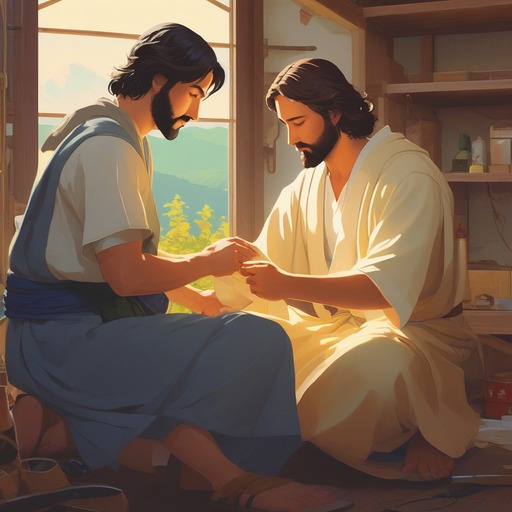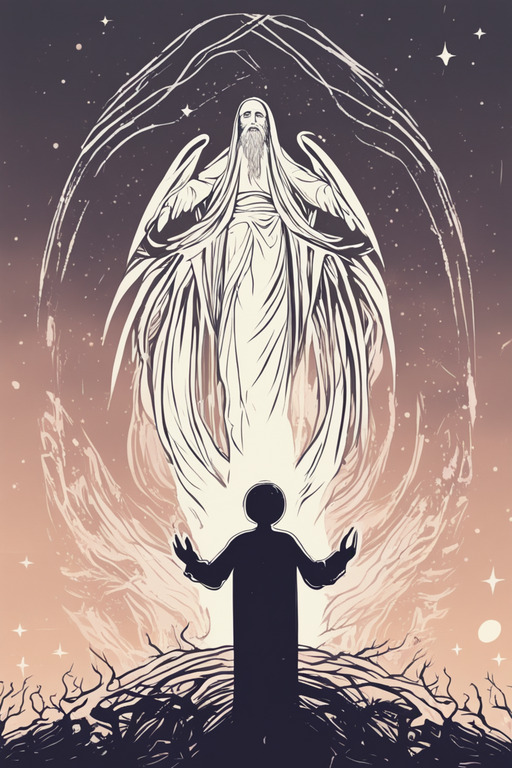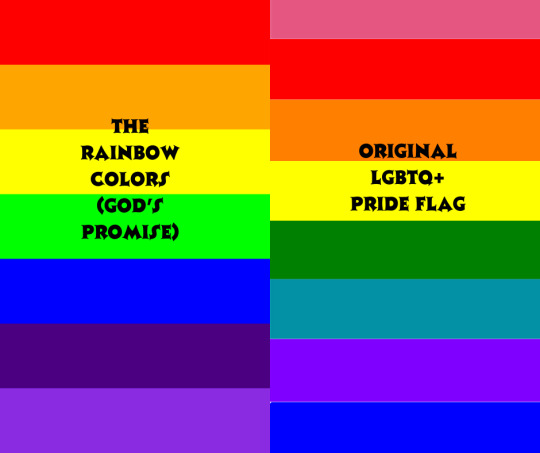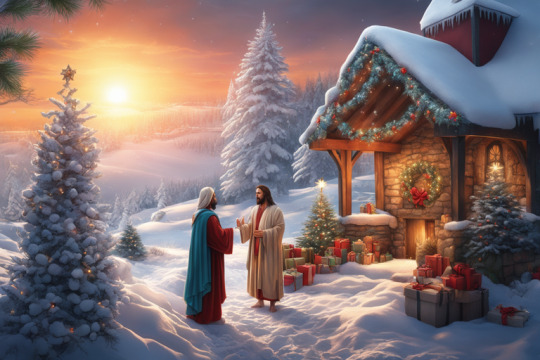Text
Go Back To the Source

A car won't last long without proper maintainance. If a part of it breaks we go to the car part's manufacturer to get replacements or have it repaired. We talk to the mechanic who does the labor for us and make sure that the car is in tip-top shape. A mechanic who studied the ins and the outs of the creator of the car.
A computer can be fixed by us, as long as we study the how's of fixing and maintaining it. If we fail, then we bring it to a computer technician, he who dedicated his life to studying and improving his life in specilizing with computers.
An MD helps us diagnose what's medically wrong with us and tells us if we need supplements or medicine. Worse, if we need operation or if we need to stay in the hospital for a period of time.
How about when we have a part in our lives that needs fixing? How about if we need things or even people on top of those, it can also be events in our lives that needs replacement? What manual do you read to troubleshoot your life? Who do you consult to find out what supplement you need for your soul and spirit? Who do you check with to know how to maintain your life properly? Bottomline... Who created you? Who "manufactured" you and your parts? Who "programmed" you? Who can "recommend" an approach to a challenge that you are facing in your life?
The creator... HE who created you. HE who created all living creatures... HE who was is the Alpha and the Omega.
#FaithInGod #faith #beliefs #christianity #reflection
0 notes
Text
Images and Idols: A Biblical Perspective

In this crucial time of spiritual warfare I've come accross this good read.
The Bible, a cornerstone of Christian faith, provides guidance on many aspects of life, including the distinction between images and idols. This article aims to explore this topic in depth, drawing from biblical references and considering both historical and modern-day contexts.
## Biblical Relevance and References
In the Bible, an **idol** is often referred to as a physical object that is worshipped as a god. This could be a statue, a carving, or any other form of physical representation that is used for the purpose of worship. The Bible warns against the creation and worship of idols in the second commandment of the Ten Commandments (Exodus 20:2-17). It is believed that idols are not gods, but are creations of human hands and are empowered by demons (1 Corinthians 10:20).
On the other hand, an **image** in the Bible can refer to a likeness or representation, but it is not necessarily worshipped. For example, in Genesis 1:26, humans are created in the "image" of God, meaning they are a reflection or likeness of God. Images themselves are not forbidden in the Bible. What is forbidden is the construction of images for the sake of worshipping the images or the gods the images portray, as well as the veneration of images as a means of venerating the God of Scripture.
## Biblical and Modern-Day Context
Historically, the prohibition against idolatry was a key distinction between the Israelites and their polytheistic neighbors. Today, this commandment continues to guide Christian practices and beliefs. In the modern context, physical idols may be less common, but idolatry can take many forms, including the excessive admiration of a person, the pursuit of wealth, or the obsession with technology.
Images, on the other hand, continue to serve as reminders or representations in many Christian traditions. For example, in Catholic tradition, statues of Jesus, Mary, and the saints are used as reminders of these figures and their lives. These statues are not considered idols because they are not worshipped as gods.
## Identifying Idol Worship
It's important to be aware of the fine line between using an image as a reminder and worshipping it as an idol. An image becomes an idol when it is worshipped or venerated in place of God. For example, in 2 Kings 18:4–5, King Hezekiah had to destroy a bronze serpent that Moses had made because the people were worshipping it as a god.
## Relevant Verses
Several verses in the Bible speak to the differences between images and idols. For instance, Exodus 20:4 warns against making an idol or any likeness of what is in heaven above or on the earth beneath. In contrast, Genesis 1:26 speaks of humans being made in the image of God.
## Praying to Images
When it comes to praying to images that represent or remind us of Christ or any heavenly person, it's important to remember that in Christian belief, prayer is directed to God alone. Images, such as crosses or statues, can serve as visual reminders of the faith and help to focus one's thoughts on God. However, they are not to be worshipped or prayed to. As stated in Exodus 20:4-5, "You shall not make for yourself an idol, or any likeness of what is in heaven above or on the earth beneath or in the water under the earth. You shall not worship them or serve them."
## Conclusion: Be Wary of Idolatry and Imagery
In conclusion, while the Bible allows for the use of images as reminders or representations, it warns against the worship of these images as idols. As believers, it's important to be mindful of this distinction and to ensure that our worship is directed towards God alone. Remember, "Little children, guard yourselves from idols" (1 John 5:21).

Sure, here are some hashtags that could help generate organic engagement for your post:
#biblestudy #faithjourney #christianlife #spiritualgrowth #BiblicalTeachings #idolsvsimages #worship #prayerlife #GodFirst #ScriptureInsights
#biblestudy#faithjourney#christianlife#spiritualgrowth#BiblicalTeachings#idolsvsimages#worship#prayerlife#GodFirst#ScriptureInsights
0 notes
Text
A Time for Surprise
Today, I want to share a small yet significant blessing that graced my life. To some, it may just be a watch, not an extravagant gift, but for me, its value transcends its monetary worth. I must admit, I'm not one to wear metal band watches, especially those of gold color. But this one is an exception. You might wonder why. It's a gift from my father-in-law.
As I was responding to my emails, awaiting a phone call, my wife entered the room. She said, "ga pinapabigay ni papa, terno daw kayo." To my surprise, it was the watch that Papa had shown me three days ago. My heart warmed instantly, and I felt loved, even if my face might not have clearly expressed it.
Three days ago, papa and I had gone out for a quick errand. While waiting, he showed me a set of watches in a photo. He said, "Nag-order ako nito oh. Ganda, may promo na pag mag add ako subong ng isa ara discount ung 2nd item." I suggested the dark-faced watch would be a good complement to the light-faced one he had already ordered. I even calculated the discount for him.
Little did I know, he planned to gift that very wristwatch to me. It's not often that I'm surprised, and even rarer that a surprise makes me feel this good. This particular event is truly special. Considering the typical dynamics between a husband and his in-laws, I can say, by God's grace, that I have been blessed not only with my foster parents but also with my in-laws.
I share this story to remind those of you who still have your fathers with you to cherish every moment. Honor them, regardless of how they treat you. My biological father and I had our fair share of heated arguments, but on his deathbed, he expressed his love for me, a love I hadn't perceived at the time. Some of you may not agree, especially those who often clash with your fathers, but when he is gone, you will miss him and wish for more time to make things right.


0 notes
Text
THE DIFFERENCE BETWEEN PRACTICE AND REHEARSAL

Here's a good read. As a dancer/choreo back in college, this hits home.
THE DIFFERENCE BETWEEN PRACTICE AND REHEARSAL
The terms "practice" and "rehearsal" are often used interchangeably, but they have distinct meanings:
**Practice** is the act of performing an activity or skill repeatedly to improve proficiency. It is a deliberate effort to develop and maintain a level of mastery in a particular area. Practice can be done alone, with a bunch of people around, or other members or partners. It can be performed at any time and place. For instance, a musician may practice scales to improve their finger dexterity, while an athlete may practice drills to enhance their speed and agility.
**Rehearsal**, on the other hand, is the act of practicing for a specific performance or event. It is often associated with the performing arts, such as theater, music, or dance, where performers practice their roles and movements in order to perfect their performance. Rehearsal is also used in other contexts, such as public speaking or sports, where individuals practice their skills in preparation for a specific event or competition. Unlike practice, a rehearsal is done before the official public performance or actual play starts. It is usually done a day or two before the actual presentation.
In summary, while both involve repetition and preparation, practice is typically about improving one's skills or abilities through consistent exercise or training, whereas rehearsal is about preparing for a specific performance or event.
Sources:
(1) Practice vs Rehearsal: How Are These Words Connected?. https://thecontentauthority.com/blog/practice-vs-rehearsal.
(2) Difference Between Practice and Rehearsal. http://www.differencebetween.net/language/words-language/difference-between-practice-and-rehearsal/.
(3) What is the difference between 'practice' and 'rehearse'? | LanGeek. https://langeek.co/en/grammar/course/1808/practice-vs-rehearse.
(4) Practice vs. Rehearsal — What’s the Difference?. https://www.askdifference.com/practice-vs-rehearsal/.
1 note
·
View note
Text
He Reaches Out To You

An interesting read that I encountered:
"I do not believe in God, but if there is any, I believe that He made me exactly the way I am. So, if I don't believe in Him that means He made me this way."
The Bible has various passages that could be interpreted in response to this statement. Here are a few:
God’s Creation: According to the Bible, God created each person uniquely (Psalm 139:13-14). This includes our personalities, talents, and even our capacity for belief.
Free Will: Many theologians interpret the Bible as saying that God gave humans free will. This means that while God created you, your beliefs and actions are your own. This is seen in passages like Deuteronomy 30:19, where God sets life and death, blessings and curses before humans and encourages them to choose life.
Faith as a Gift: In Ephesians 2:8-9, it’s written that faith is a gift from God, not something that comes from ourselves. This could be interpreted to mean that belief in God is something that He instills in us.
Seeking God: The Bible often encourages seeking God. Verses like Jeremiah 29:13 state that those who seek God will find Him.
As always, take the verses into context too. As for me, yes I agree to a certain extent, God did create us exactly the way we are with the power of choice. The way we are now and the way our current individual beliefs are, we need to consider our past choices as well that lead us to our current individual beliefs.
Remember, God did make us in His likeness, but He is a loving Father and He respects our choices. He will do everything to bring us back to Him, but if He sees that your heart does not want to belong with Him, He will respect that choice and let you be with your ways. We should also consider how we reacted, progressed, and decided to live our lives as the people of this world had treated us. That may have been a big factor that created that gap.
No matter who you are, where you are, and what your belief is, I hope that you and your family stays safe.
0 notes
Text
Heaven's Rainbow and the Worldy Rainbow

Disclaimer: This read may not go along with a lot of people. This is just something that I cam across and is a good to know article for most (if not all). I understand if a lot in my list would be unfriending me for this. I believe we just have to be more aware of these things too.
Heaven's Rainbow and the Worldly Rainbow: Their Significance, Differences, and Similarities.
Worldly Rainbow:
The rainbow flag is a symbol of the LGBTQ+ community and is widely recognized as a symbol of pride. It was created in 1978 by Gilbert Baker, an artist, designer, Vietnam War veteran, and then-drag performer1. Harvey Milk, one of the first openly gay elected officials in the U.S., commissioned Baker to create a flag that would represent the gay community12. The original flag had eight colors: pink, red, orange, yellow, green, turquoise, blue, and violet1. The colors were meant to represent diversity and inclusivity within the LGBTQ+ community1.
The flag was first flown in San Francisco’s United Nations Plaza for Gay Pride Day on June 25, 19781. It quickly became the most popular symbol of gay pride and has become a ubiquitous symbol of Pride today1.
Since then, the rainbow flag has undergone several changes. The original eight-color version was reduced to six colors in 1979 due to production issues2. The current version of the flag has six stripes: red, orange, yellow, green, blue, and purple3. Each color represents a different aspect of the LGBTQ+ community. Red represents life; orange represents healing; yellow represents sunlight; green represents nature; blue represents harmony; and purple represents spirit3.
Gilbert Baker designed the rainbow flag as a symbol of pride for the LGBTQ+ community at the request of Harvey Milk. The original eight-color flag represented diversity and inclusivity within the community. Today’s six-color version has become a ubiquitous symbol of Pride that represents different aspects of the LGBTQ+ community.
Gilbert Baker was an artist, designer, and activist who is best known as the creator of the rainbow flag, a symbol of the LGBTQ+ community. According to a CNN article, Baker was inspired by the Bible and the American flag when he created the rainbow flag. He believed that the rainbow was a symbol of hope and that it represented diversity and inclusivity within the LGBTQ+ community.
There was no information about Baker's religious views or beliefs. However, he was an advocate for human rights and social justice. In 2017, Baker passed away at the age of 65.
Harvey Milk was an American politician and gay-rights activist who was one of the first openly gay elected officials in the United States. According to a Freedom From Religion Foundation article, Milk was very critical of organized religion and did not attend religious services. In one of his recorded wills, Milk said of his funeral: "I hope there are no religious services".
However, according to a Them article, Milk struggled with Judaism growing up and thought that religion in general was peppered with falsehood and hypocrisy. It remained central to his identity, and he actively shared about himself during a time when being Jewish was still derided by general society.
Lillian Faderman, a distinguished scholar of LGBT and ethnic history and literature, wrote that as an adult, Milk rejected the religion in which he’d been brought up but adhered closely to one of its major tenets.
The Colors and their Meanings:
The rainbow flag has six colors, each of which represents a different aspect of the LGBTQ+ community. Here are the meanings of each color:
Original Colors:
1. Pink: Represents sex.
2. Red: Represents life.
3. Orange: Represents healing.
4. Yellow: Represents sunlight.
5. Green: Represents nature.
6. Turquoise: Represents magic/art.
7. Blue: Represents harmony.
8. Violet: Represents spirit.
Current Colors:
1. Red: Represents life.
2. Orange: Represents healing.
3. Yellow: Represents sunlight.
4. Green: Represents nature.
5. Blue: Represents harmony.
6. Purple: Represents spirit.
Source: Conversation with Bing, 10/6/2023
Rainbow flag (LGBT) - Wikipedia. https://en.wikipedia.org/wiki/Rainbow_flag_%28LGBT%29.
Rainbow Flag Color Codes - HTML Hex, RGB and CMYK Color Codes. https://brandpalettes.com/rainbow-flag-color-codes/.
Pride (Rainbow) flag color codes. https://www.flagcolorcodes.com/pride-rainbow.
What Do the Colors of the New Pride Flag Mean? - Verywell Mind. https://www.verywellmind.com/what-the-colors-of-the-new....
Harvey Milk | Biography, Facts, & Assassination | Britannica. https://www.britannica.com/biography/Harvey-Milk.
Harvey Milk - Freedom From Religion Foundation. https://ffrf.org/ftod-cr/item/14969-harvey-milk.
Harvey Milk’s Iconic Activism Took Root in His Adolescence | Them. https://www.them.us/story/harvey-milk-adolescent-roots.
Harvey Milk's Jewish Identity - Yale University Press. https://yalebooks.yale.edu/.../harvey-milks-jewish-identity/.
Rainbow flag maker was inspired by Bible, U.S. flag | CNN. https://www.cnn.com/.../rainbow-flagmaker.../index.html.
Gilbert Baker (artist) - Wikipedia. https://en.wikipedia.org/wiki/Gilbert_Baker_%28artist%29.
Biography | Gilbert Baker. https://gilbertbaker.com/biography/.
On Gilbert Baker's Passing, Why Rainbow Flags Are Needed in Catholic .... https://www.newwaysministry.org/.../on-gilbert-bakers.../.
Other References:
1. history.com
2. britannica.com
3. en.wikipedia.org
4. bing.com
5. bbc.com
6. gettyima
Heaven's Rainbow:
According to the Bible, the rainbow is a symbol of God's promise to never again destroy the earth with a flood. After the great flood, God made a covenant with Noah and his family, promising that he would never again destroy the earth with a flood. As a sign of this covenant, God set a rainbow in the sky.
The rainbow has been used as a symbol of hope and promise in many cultures throughout history. In Greek mythology, for example, the rainbow was seen as a path between heaven and earth. In Norse mythology, the rainbow was believed to be a bridge between the world of humans and the world of the gods.
In Christianity, the rainbow is seen as a symbol of God's grace and mercy. It is also seen as a reminder of God's promise to never again destroy the earth with a flood. The rainbow is mentioned several times in the Bible, including in Genesis 9:13-16, where God says: "I have set my rainbow in the clouds, and it will be the sign of the covenant between me and the earth".
In Christian tradition, each color of the rainbow has a special meaning. Here are the meanings of each color:
1. Red: Represents the blood that Jesus shed for our sins
2. Orange: Represents passion, especially that of the Fire of God
3. Yellow: Represents sunlight
4. Green: Represents nature
5. Blue: Represents harmony
6. Purple: Represents spirit
7. Indigo: Represents forgiveness
Source: Conversation with Bing, 10/6/2023
What Does God Promise With a Rainbow? - Billy Graham Evangelistic .... https://billygraham.org/.../what-does-god-promise-with-a.../.
Does the rainbow have a meaning? What is the biblical significance of .... https://www.compellingtruth.org/meaning-of-the-rainbow.html.
Rainbows In The Bible: 3 Of God's Promises - Woman of Noble Character. https://www.womanofnoblecharacter.com/rainbows-in-the-bible/.
Rainbow Symbolism In Christianity And Its Meaning. https://christian.net/.../rainbow-symbolism-in.../.
Biblical Principle #58: Rainbow a Sign of God’s Promise. https://chasingalion.com/rainbow/.
christian.net
angelicalbalance.com
billygraham.org
dualseedlinechristianidentity.home.blog
theblogginghounds.com
#love
#instagood
#photooftheday
#fashion
#beautiful
#happy
#cute
#tbt
#like4like
#followme
0 notes
Text
Woke

Another good read for awareness:
The phrase "stay woke" is broadly used to describe a state of being "aware of and actively attentive to important facts and issues especially of racial and social injustice" according to the Merriam-Webster dictionary¹. It originated from African American Vernacular English (AAVE) in the early part of the 20th century¹. The term has become a common part of American slang and its usage has evolved over time.
The phrase "stay woke" has long been used in Black communities to indicate staying alert to others' deception--especially law enforcement--as a survival mechanism¹. However, in 2014 "stay woke" became common usage among Black Lives Matter activists after the police killing of Michael Brown, bringing it into the wider lexicon.
The first documented usage of the term "stay woke" was by Black folk singer Lead Belly when he was talking about his 1938 song "Scottsboro Boys". The song referred to "nine Black teens falsely accused of raping two white women in 1931, [who] were sentenced to death. NAACP forced repeated retrials. They were finally freed but never recovered". In an interview about the song, Lead Belly—who was born Huddie Ledbetter—said, "Stay woke, keep your eyes open".
The original usage of "stay woke" was a call to remain vigilant and aware, particularly in the face of systemic injustices. It was used within the Black community as a warning to be conscious of the potential for deception, especially from law enforcement. This usage was deeply rooted in the historical context of racial discrimination and social injustice.
In modern times, the phrase "stay woke" has been adopted by a wider audience, particularly in the context of the Black Lives Matter movement. It has come to symbolize a broader awareness of social and political injustices. The phrase is often used in discussions about racial inequality, police brutality, and other social justice issues.
While the phrase has evolved to encompass a wider range of issues, its core meaning remains the same: to stay alert and aware, particularly in the face of systemic injustices.
Source: Conversation with Bing, 10/6/2023
What Are the Origins of the Term ‘Stay Woke’? - Snopes.com. https://www.snopes.com/articles/464795/origins-term-stay-woke/.
What is woke: How a Black movement watchword got co-opted in a ... - Vox. https://www.vox.com/culture/21437879/stay-woke-wokeness-history-origin-evolution-controversy.
How has the meaning of the word “woke” evolved? - The Economist. https://www.economist.com/the-economist-explains/2021/07/30/how-has-the-meaning-of-the-word-woke-evolved.
Stay Woke - What does it mean to stay woke? - Slang.net. https://slang.net/meaning/stay_woke.
What does woke really mean? | WORLD. https://wng.org/articles/what-does-woke-really-mean-1674277350.
0 notes
Text
Halloween. Is it a win?

This is for awareness and just a little bit of good read. Not intended to be a downer:
Halloween, celebrated each year on October 31, originated with the ancient Celtic festival of Samhain1. The Celts, who lived 2,000 years ago in the area that is now Ireland, the United Kingdom, and northern France, celebrated their new year on November 11. This day marked the end of summer and the harvest and the beginning of the dark, cold winter, a time of year that was often associated with human death1.
Celts believed that on the night before the new year, the boundary between the worlds of the living and the dead became blurred1. On the night of October 31, they celebrated Samhain, when it was believed that the ghosts of the dead returned to earth1. To commemorate the event, Druids built huge sacred bonfires, where people gathered to burn crops and animals as sacrifices to the Celtic deities1. During the celebration, the Celts wore costumes, typically consisting of animal heads and skins, and attempted to tell each other’s fortunes1.
In terms of biblical connections, there are no direct references to Halloween in the Bible2. Some Christians believe that participating in Halloween is a form of involvement in the worthless deeds of evil and darkness, which is forbidden in Scripture: Ephesians 5:7-152. However, others consider modern-day Halloween activities to be harmless fun2. The Bible is actually completely silent on Halloween since it did not exist during the time when the books of the Bible were written3.
It’s important to note that while some people have connected Halloween to earlier pagan celebrations of the new year, Halloween actually has significant Catholic roots. The name itself comes from All Hallow’s Eve – that is, the Vigil of All Saints’ Day, when Catholics remember those who have gone before us to enter our heavenly home.
Halloween has been around for more than a thousand years1. Originally a religious observance, it became increasingly secular over the centuries until its religious trappings all but disappeared1. Today, Halloween is considered a holiday for dress-up and fun, especially for children1.
The custom of trick-or-treating, in which children dress up in costume and solicit treats from neighbors, became popular in the United States in the early 20th century as Irish and Scottish communities revived the Old World custom of “guising,” in which a person would dress in costume and tell a joke, recite a poem, or perform some other trick in exchange for a piece of fruit or other treat1. By 1950, trick-or-treating for candy had become one of Halloween’s most popular activities1. Today, Halloween is one of the biggest holidays for candy sales in the United States, estimated to be more than $3 billion1.
While Halloween may not have direct biblical connections, it has evolved into a community-centered holiday. It encourages creativity through costumes and decorations, brings neighborhoods together through trick-or-treating and parties, and is seen as a fun way to celebrate the fall season. It’s important to note that how one chooses to celebrate Halloween is often a personal decision based on their own beliefs and traditions.
References:
1. history.com
2. learnreligions.com
3. christianity.com
4. vaticannews.va
5. britannica.com
6. earthobservatory.nasa.gov
7. edsitement.neh.gov
8. biblestudy.org
9. britannica.com
10. history.com
11. today.com
12. hindustantimes.com
#HalloweenOrigins
#samhainfestival
#celticnewyear
#allhallowseve
#trickortreat
#halloweencostumes
#halloweencelebration
#communityholiday
#fallseason
#HalloweenOrigins#samhainfestival#celticnewyear#allhallowseve#trickortreat#halloweencostumes#halloweencelebration#communityholiday#fallseason
1 note
·
View note
Text
Jesus and Christmas - Origins

The exact date of Jesus’s birth is not stated in the gospels or in any historical sources. Most biblical scholars generally accept a date of birth between 6 BC and 4 BC, the year in which King Herod died1. The historical evidence is too incomplete to allow a definitive dating1. Some research done by members of the Church of Jesus Christ of Latter-day Saints generally places the birth of Jesus at some point in early to mid April1.
The common Christian traditional dating of the birthdate of Jesus was December 25, a date first asserted officially by Pope Julius I in 350 AD1. The church in Rome began formally celebrating Christmas on December 25 in 336, during the reign of the emperor Constantine2. As Constantine had made Christianity the effective religion of the empire, some have speculated that choosing this date had the political motive of weakening the established pagan celebrations2. The decision to celebrate Christmas on December 25 was made sometime during the fourth century by church bishops in Rome3.
It’s important to note that while December 25 is celebrated as Christmas day, it may not be the actual birth date of Jesus. The selection of this date has more to do with Christian history and tradition rather than historical accuracy.
Learn more:
1. en.wikipedia.org2. britannica.com3. gty.org4. christianity.com5. bibleinfo.com6. history.com7. fee.org
The relationship between Jesus’s birth and Christmas day is largely based on tradition and historical context, rather than specific biblical or historical evidence. The Bible does not specify the exact date of Jesus’s birth12.
In the fourth century, Pope Julius I chose December 25 as the date of the Feast of the Nativity2. This date was not immediately universally accepted and it took some time for it to be widely recognized. For instance, Christmas wasn’t celebrated in England until the end of the sixth century, and didn’t reach northern Europe until the end of the eighth century2.
One theory as to why December 25 was chosen is that it coincided with existing pagan festivals. In Rome, Saturnalia – a festival honoring Saturn, the god of agriculture – began just before the winter solstice and continued for seven days2. In Scandinavia, the Norse celebrated ‘Jul’ (Yule) from the winter solstice for about 12 days2. By choosing this date, it’s suggested that Pope Julius I may have intended to appropriate these pagan celebrations and transform them into a Christian occasion2.
However, it’s important to note that while December 25 is celebrated as Christmas day, it may not be the actual birth date of Jesus. The selection of this date has more to do with Christian history and tradition rather than historical accuracy.
Learn more:
1. newsweek.com2. theguardian.com3. ucg.org4. washingtonpost.com5. crosswalk.com
0 notes
Text
Faith and Perception
The Intersection of Faith and Perception: A Journey Towards Universal Reality

The journey of faith is often a solitary one, marked by personal experiences that can be difficult to articulate to others. This journey can be particularly challenging when it intersects with worldly perception. Those who embark on this path towards understanding God often find themselves questioned by those who do not share their beliefs. They are perceived as insane by those who are entrenched in worldly realities, unable to comprehend the universal reality that transcends our physical world12.
Biblical References
The Bible provides numerous references that echo this sentiment. In the book of James, the apostle puts the faith of believers on trial, arguing that true faith lives by God’s wisdom instead of secular, worldly wisdom1. He describes how God’s wisdom is from above and how worldly wisdom is earthly, natural, and demonic1. This dichotomy between divine and worldly wisdom underscores the challenges faced by those who seek to understand God.
In another biblical reference, we find an account of spiritual perception in the Gospel of Mark. Jesus, aware of the reasoning within the hearts of those around him, questions why they harbor such thoughts2. This passage highlights the contrast between spiritual perception and worldly understanding.
Historical Anecdotes
Historically, many figures have grappled with this intersection of faith and perception. Saint Augustine of Hippo, a renowned theologian, presents an autobiographical account of his life leading up to his conversion to Christianity3. He offers honest and vulnerable rumination on his wayward past and former worldly attitudes, tracing his path to reconciliation with his Divine Creator3. Augustine’s journey from disbelief to spiritual reconciliation underscores the transformative power of faith.
The Christian Community and the World
From a sociological perspective, the Christian community has been related to the world in diverse and even paradoxical ways4. This relationship reflects changes over time and simultaneously expressed alternatives ranging from withdrawal from and rejection of the world to theocratic triumphalism4. This complex relationship between the Christian community and the world further illustrates the tension between faith and worldly perception.
Conclusion
The journey towards understanding God is a deeply personal one, often fraught with challenges as it intersects with worldly perception. However, through biblical teachings and historical anecdotes, we see that this journey is not only possible but also transformative. It invites us to transcend our physical reality and embrace a universal reality that offers a deeper understanding of our existence.
Learn more:
1. bible.org2. bible.knowing-jesus.com3. worldhistory.org4. britannica.com5. biblestudytools.com6. whatchristianswanttoknow.com7. crossway.org8. britannica.com
#FaithJourney#SpiritualPerception:#BiblicalWisdom#DivineVsWorldly#UniversalRealit#FaithAndPerception
0 notes
Text
Do Real Men Wear Pink?
Yes, the color pink was indeed associated with boys in the past. The association of pink with femininity is a relatively recent development. Here’s a brief history:
In the 18th century, both boys and girls of the upper classes wore pink and blue uniformly1. Pink was even considered to be a masculine color1.
Pink was related to the mother color of red, which was seen as ardent, passionate, active, and aggressive1. An article published in 1918 stated that the generally accepted rule was pink for boys and blue for girls1.
However, by the 1890s and early 20th century, manufacturers attempted to sell more children’s clothes by color-coding them1. Some manufacturers branded pink for boys and blue for girls, and vice versa1.
The acquisition of two 18th-century paintings by American millionaire Henry Huntington started turning the tide in favor of pink being a girls’ color1. The paintings were “The Blue Boy” (depicting a boy dressed in blue) and “Pinkie” (portraying a girl in pink attire) and their purchase was widely publicized in the American press1.
The current convention of pink for girls and blue for boys wasn’t established until the 1940s2.
So, while pink is overwhelmingly associated with delicacy and femininity today, this wasn’t always the case. It’s interesting how societal norms and perceptions can change over time!
Learn more:
1. cnn.com2. smithsonianmag.com3. colorsexplained.com4. en.wikipedia.org5. link.springer.com
#organic#plantextract#usdaorganic#tumeric#organicveggies#turmericpowder#neemoil#goorganic#chemicalfree#organicbeauty#organicfood
0 notes
Text
Mr. Buddy has gone to the Margaritaville in the sky, which makes me sad for the obvious reasons, but also makes me sad because Mr. Buddy is such a good name and now I can't ever use it again

riperoni misteroni
130 notes
·
View notes
Text
The Silent Departure: When Men Choose to Leave

In the quiet corners of our lives, where love and loss intertwine, there exists a phenomenon that is both heartbreaking and perplexing. It’s the moment when a man chooses to leave his partner, not because of a lack of love, but because he feels his existence has no positive effect on his spouse. This decision, often shrouded in a cloud of sadness and tragedy, can leave a lasting impact on the lives of those left behind.
The Biblical Perspective
The Bible, a source of wisdom for many, offers insights into relationships that can shed light on this phenomenon. In Proverbs 13:20, it is written: "Walk with the wise and become wise, for a companion of fools suffers harm."1 This verse suggests that our companions significantly influence our lives. If a man perceives himself as causing harm rather than providing wisdom and support to his partner, he may choose to remove himself from the equation.
In 1 Peter 4:8, we find another relevant verse: "Above all, love each other deeply, because love covers over a multitude of sins."1 Love is meant to be a healing force, a balm for our shortcomings. But what happens when a man feels his sins or failures are too great to be covered by love? The tragic answer may be that he chooses to leave.
The Reality Check: Survey Insights
Surveys and studies provide a more contemporary perspective on this issue. According to one study, only 6% of marriages end when someone becomes unwell during the marriage2. However, it’s usually men who choose to leave2. This statistic is startling and sad. It suggests that when faced with significant challenges or changes, some men feel their presence is more harmful than helpful.
Anecdotes: Stories of Silent Goodbyes
There are countless stories of men leaving their partners at critical moments. One such story involves a woman battling stage four breast cancer2. Her husband initially supported her but eventually withdrew as her health declined2. These stories are heartbreaking reminders of the silent departures that occur when men feel they can’t positively contribute to their partners’ lives.
A Focused Message: Awareness and Understanding
The crux of this issue lies in understanding and awareness. It’s crucial for individuals in a relationship to recognize if they’re making their partner’s existence feel invalid or unhelpful due to their struggles. Open communication, empathy, and understanding are vital in ensuring that both parties feel valued and positive in their relationship.
In conclusion, the silent departure of men from their partners’ lives is a complex issue rooted in perceptions of self-worth and the ability to contribute positively to their partners’ lives. By fostering open communication and understanding within relationships, we can hope to address this heartbreaking phenomenon.
Learn more:
1. biblestudytools.com2. theguardian.com3. bible.knowing-jesus.com4. biblestudytools.com5. christian
#Relationships#LoveAndLoss#SilentDeparture#BiblicalInsights#SurveyInsights#RealLifeStories#CommunicationInRelationships#UnderstandingAndEmpathy
0 notes
Text
The Unspoken Battle: A Man’s Silent Struggle with Despair and Heartache

In the unseen corners of countless homes, a silent battle rages on. It is the struggle of a man who, despite his best efforts, finds himself unable to provide for his family. This man is not unique in his plight. There are many others like him, grappling with feelings of despair and inadequacy, their hearts burdened by the harsh realities of their circumstances.
The Weight of Inadequacy
The inability to provide for one’s family can be a crushing blow for a man. Society often assigns the role of provider to men, and when they are unable to fulfill this role, it can lead to feelings of failure and worthlessness. He watches as his wife becomes increasingly anxious about their situation, her face etched with worry and fear. Each sigh she lets out, each furrowed brow, each restless night, is a dagger to his heart.
The Fight Against All Odds
This man has left no stone unturned. He has tirelessly sought employment, faced countless rejections, and taken on odd jobs that require long hours for meager pay. Yet despite his relentless efforts, it never seems enough.
A Journey of Faith
Amidst this struggle, the man holds steadfastly onto his faith in Christ. He prays earnestly, seeking solace and guidance in God’s word. He believes in God’s promise to provide for His children and patiently awaits His provision. Yet even as he treads this path of faith, he is tormented by feelings of despair and helplessness.
The Dark Thoughts
In his darkest moments, the average man may even contemplate death as an option. Not out of selfishness or a desire to escape his problems, but out of a heartbreaking belief that his death might alleviate the burden on his family. That his absence might somehow improve the morale of his loved ones.
The Silent Scream
This is the silent scream of a man caught in an agonizing battle with despair and heartache. It is a cry that resonates in the hearts of many men worldwide. Yet it is a cry that often goes unheard, drowned out by societal expectations and the hustle and bustle of daily life.
By sharing this story, we aim to bring attention to this silent struggle and remind everyone that it’s okay to seek help. It’s okay to admit that you’re hurting. And most importantly, it’s okay to lean on your faith during these challenging times.
Remember, you are not alone in your struggle. Reach out to those around you - your friends, your family, your church community. Let them share your burden. And above all else, hold onto hope. For as long as there is hope, there is a way forward.
#MentalHealthAwareness#PersonalGrowth#Psychotherapy#Selflove#SelfCareMatters#MentalHealthAdvocate#EndTheStigmaOfMentalHealth#MentalWellness#MentalIllnessRecovery#AnxietyAwareness
0 notes
Text
Iceland was named by a Norwegian Viking named Hrafna-Flóki Vilgerðarson. According to the Book of Settlements, Hrafna-Flóki sailed to Iceland from Norway with his family and livestock with the intention to settle in the new country. The story goes that he was named Hrafna-Flóki, which means Raven-Flóki, because of the three ravens he brought with him on his journey to Iceland to help him find his way to the island around 865 AD. That first winter, all of his livestock died, causing him to decide to leave the island. However, before leaving, he looked over the fjord of Vatnsfjörður and saw that it was full of ice, leaving him to name the place Iceland1.
Greenland was named by a Viking named Erik the Red. Historians believe Erik chose the name Greenland as a marketing strategy. The word “green” promised people from elsewhere in the Nordics they would find lush, green fields waiting for them in the new region2. Some people also say that the Vikings named Iceland to discourage over settlement on the island. Just as the name “Greenland” aimed to attract new locals, the name Iceland created visions of a cold, unwelcoming atmosphere2.
Learn more:
1. theculturetrip.com2. scandification.com3. icelanddiscover.is4. bluecarrental.is5. icelandreview.com6. en.wikipedia.org7. knowswhy.com8. snopes.com
#Here are some relevant hashtags that you can use to generate organic engagement for the previous result:#Iceland#Greenland#Vikings#ErikTheRed#HrafnaFlóki#Nordics#History#Geography
0 notes
Text
Iceland was named by a Norwegian Viking named Hrafna-Flóki Vilgerðarson. According to the Book of Settlements, Hrafna-Flóki sailed to Iceland from Norway with his family and livestock with the intention to settle in the new country. The story goes that he was named Hrafna-Flóki, which means Raven-Flóki, because of the three ravens he brought with him on his journey to Iceland to help him find his way to the island around 865 AD. That first winter, all of his livestock died, causing him to decide to leave the island. However, before leaving, he looked over the fjord of Vatnsfjörður and saw that it was full of ice, leaving him to name the place Iceland1.
Greenland was named by a Viking named Erik the Red. Historians believe Erik chose the name Greenland as a marketing strategy. The word “green” promised people from elsewhere in the Nordics they would find lush, green fields waiting for them in the new region2. Some people also say that the Vikings named Iceland to discourage over settlement on the island. Just as the name “Greenland” aimed to attract new locals, the name Iceland created visions of a cold, unwelcoming atmosphere2.
Learn more:
1. theculturetrip.com2. scandification.com3. icelanddiscover.is4. bluecarrental.is5. icelandreview.com6. en.wikipedia.org7. knowswhy.com8. snopes.com
0 notes
